Jetstar Asia, Singapore’s pioneering low-cost airline, concluded its 20-year journey on July 31, 2025, with its final flight departing from Changi Airport. Launched in 2004, the carrier connected millions of travelers across Asia and Australia, offering budget-friendly fares and regional accessibility. Below, we trace Jetstar Asia’s history, from its ambitious beginnings to its expansion and eventual closure.
The Launch: Entering the Low-Cost Arena
In April 2004, Australia’s Qantas Group partnered with Singaporean investors Tony Chew, FF Wong, and Temasek Holdings to establish Jetstar Asia, investing S$100 million. Qantas held a 49% stake, with the remainder split among local partners. Positioned to serve destinations within a five-hour radius of Singapore, Jetstar Asia aimed to outshine competitors like Valuair and Tiger Airways, which focused on shorter routes. The airline’s inaugural flight to Hong Kong took off on December 13, 2004, with fares starting at S$28 to Pattaya and S$88 to Taipei. Initial routes included Jakarta, Manila, and Taipei, though regulatory delays in China and Indonesia posed early challenges.
Securing its Air Operator’s Certificate in November 2004, Jetstar Asia established Changi Airport as its hub, feeding passengers into Jetstar Airways’ Australian network. The airline’s mission was clear: make air travel affordable and accessible across the region.
Expansion: Growing Across Asia
Jetstar Asia quickly expanded its footprint. In 2005, it merged with Valuair, strengthening its position in Southeast Asia’s competitive market. In 2006, it became the first international airline to land at Bangkok’s Suvarnabhumi Airport, a significant milestone. That year, Qantas unified its Jetstar brands, enhancing global recognition. By 2011, Jetstar Asia introduced long-haul flights to Auckland and Melbourne using Airbus A330s, a first for a Singapore-based low-cost carrier.
The airline’s network grew to encompass Southeast Asia (Thailand, Vietnam, Indonesia) and East Asia (Japan, Taiwan, Hong Kong). In 2011, it carried 2.7 million passengers, an 18% increase, with revenue passenger kilometers rising 39.7%. New routes, such as Okinawa and Hat Yai in 2017, and plans for Colombo in 2020 (disrupted by COVID-19), underscored its ambition. Financially, Jetstar Asia saw success, with a 20% revenue increase by March 2008 and S$18 million in profit for the year ending June 2011, driven by a 46% capacity expansion.
In 2009, Temasek sold its stake, leaving Qantas with 49% and Singaporean Dennis Choo’s Westbrook Investments with 51%. In 2010, Jetstar Asia’s selection of Singapore as its Asian hub reinforced Changi’s status as a low-cost aviation center. Valuair was fully integrated into Jetstar Asia by 2006 and ceased independent operations, while Tiger Airways merged with Scoot in 2017 and now operates under Scoot’s brand.
Challenges and Closure: The Final Descent

Jetstar Asia faced ongoing challenges. By late 2005, financial losses prompted a CEO change, with Ken Ryan replaced by Chong Phit Lian in 2006. The low-cost sector’s fierce competition, led by AirAsia and Lion Air, strained profitability. Stephanie Tully, appointed Jetstar Group CEO in 2022, noted that Jetstar Asia was profitable in only six of its 20 years.
The COVID-19 pandemic exacerbated difficulties. In March 2020, Jetstar Asia suspended operations, grounding its 18 Airbus A320s and furloughing staff. By June, it reduced its workforce by 180 and retired five aircraft. On June 11, 2025, Qantas and Westbrook Investments announced the airline’s closure, citing supplier cost increases of up to 200%, high airport fees, and intense competition, projecting an A$35 million loss for 2025. The final flight on July 31 ended 16 intra-Asia routes, including unique destinations like Okinawa and Broome.

Over 500 employees received severance packages, including four weeks’ pay per year of service, bonuses, and travel benefits, with job placement support from Singapore Airlines and unions. The 13 A320s were reassigned to Jetstar Airways and QantasLink, releasing A$500 million for fleet renewal. Affected passengers were offered refunds or alternative Qantas Group flights.
A Lasting Legacy
In 2024, Jetstar Asia carried 2.3 million passengers through Changi, cementing its role in affordable travel. While its closure marks the end of an era, its 20-year legacy of connecting Asia endures. As other airlines absorb most of its routes, Jetstar Asia’s contribution to accessible air travel remains a cherished chapter in the region’s aviation story.





